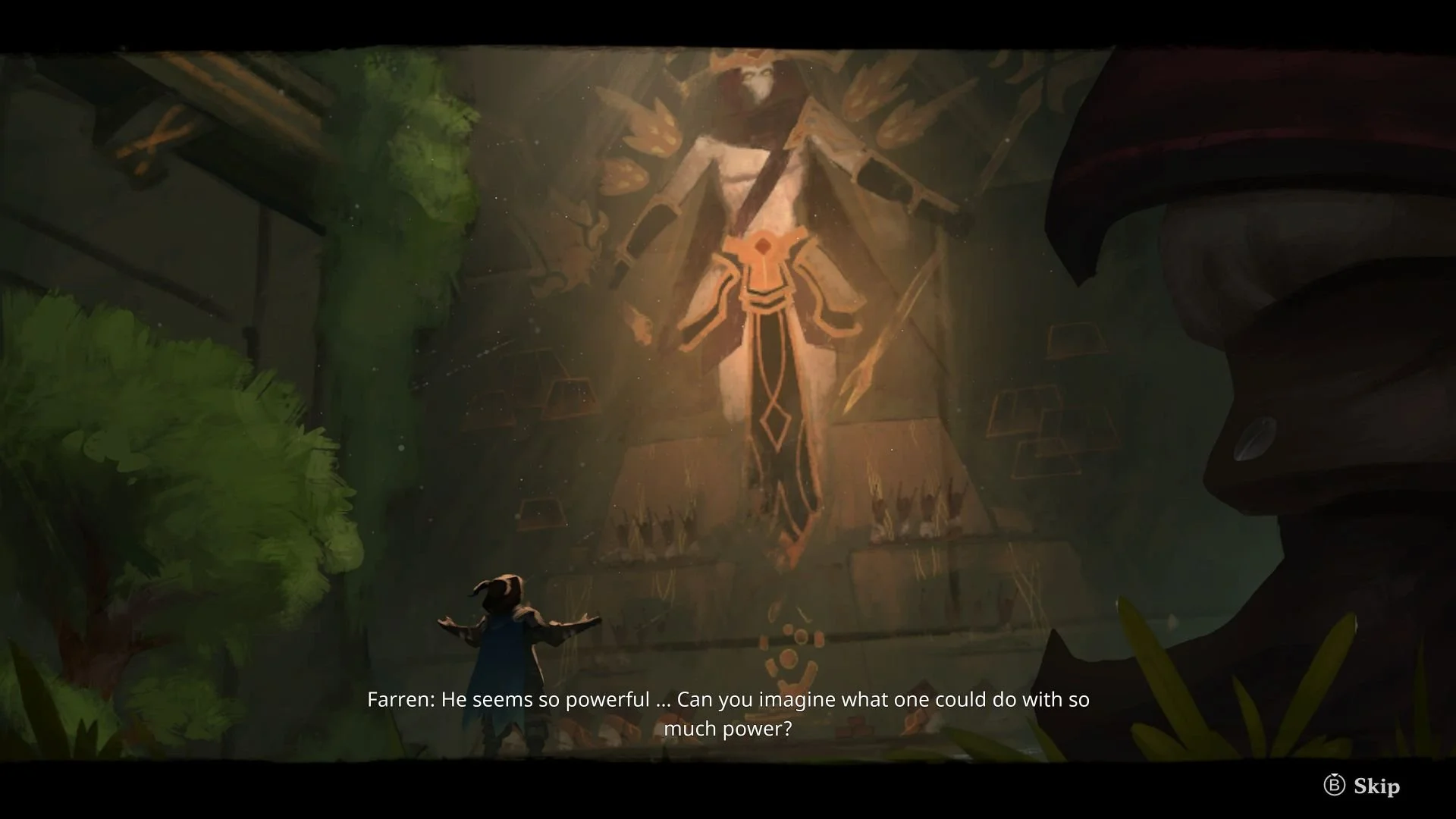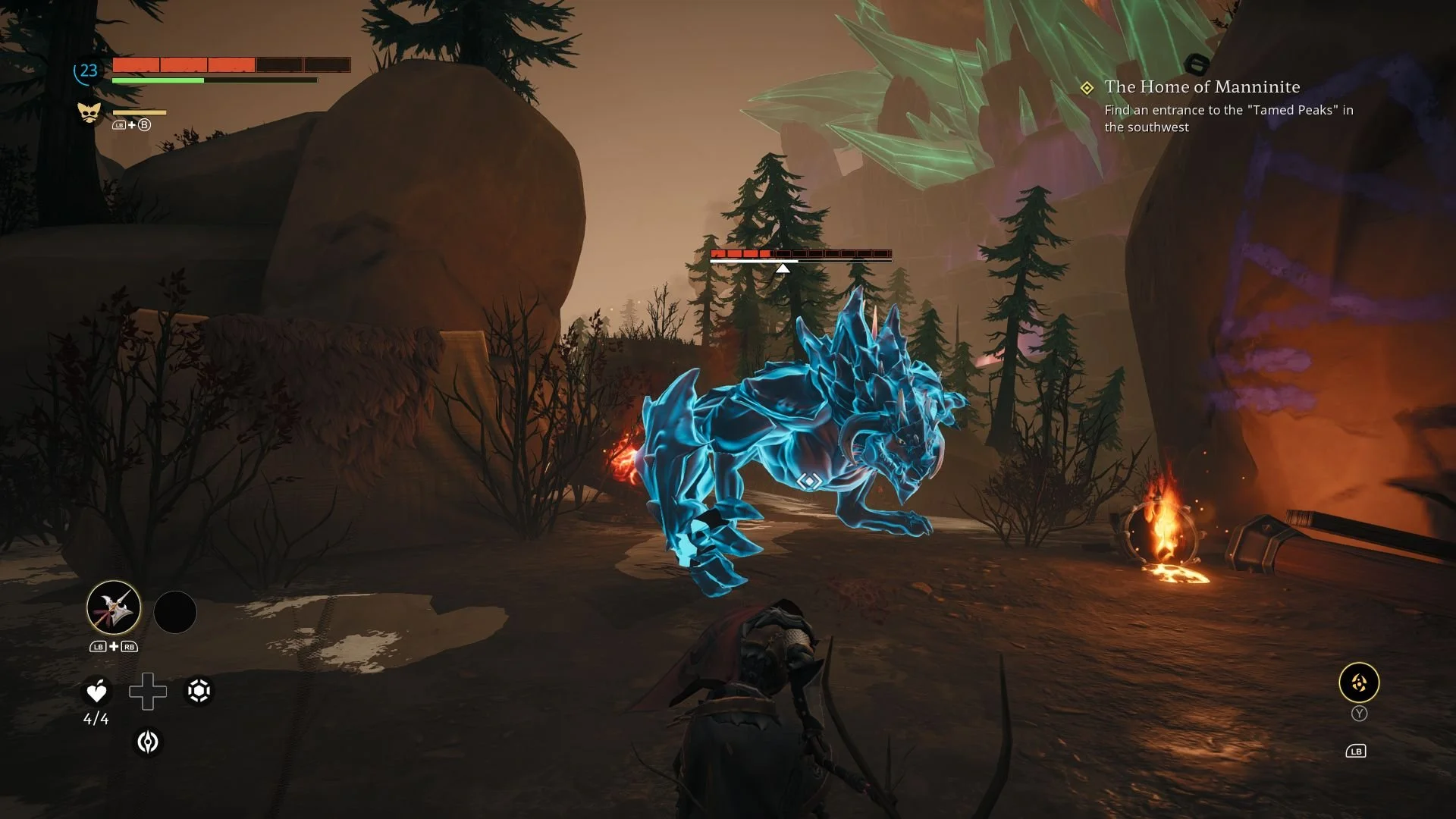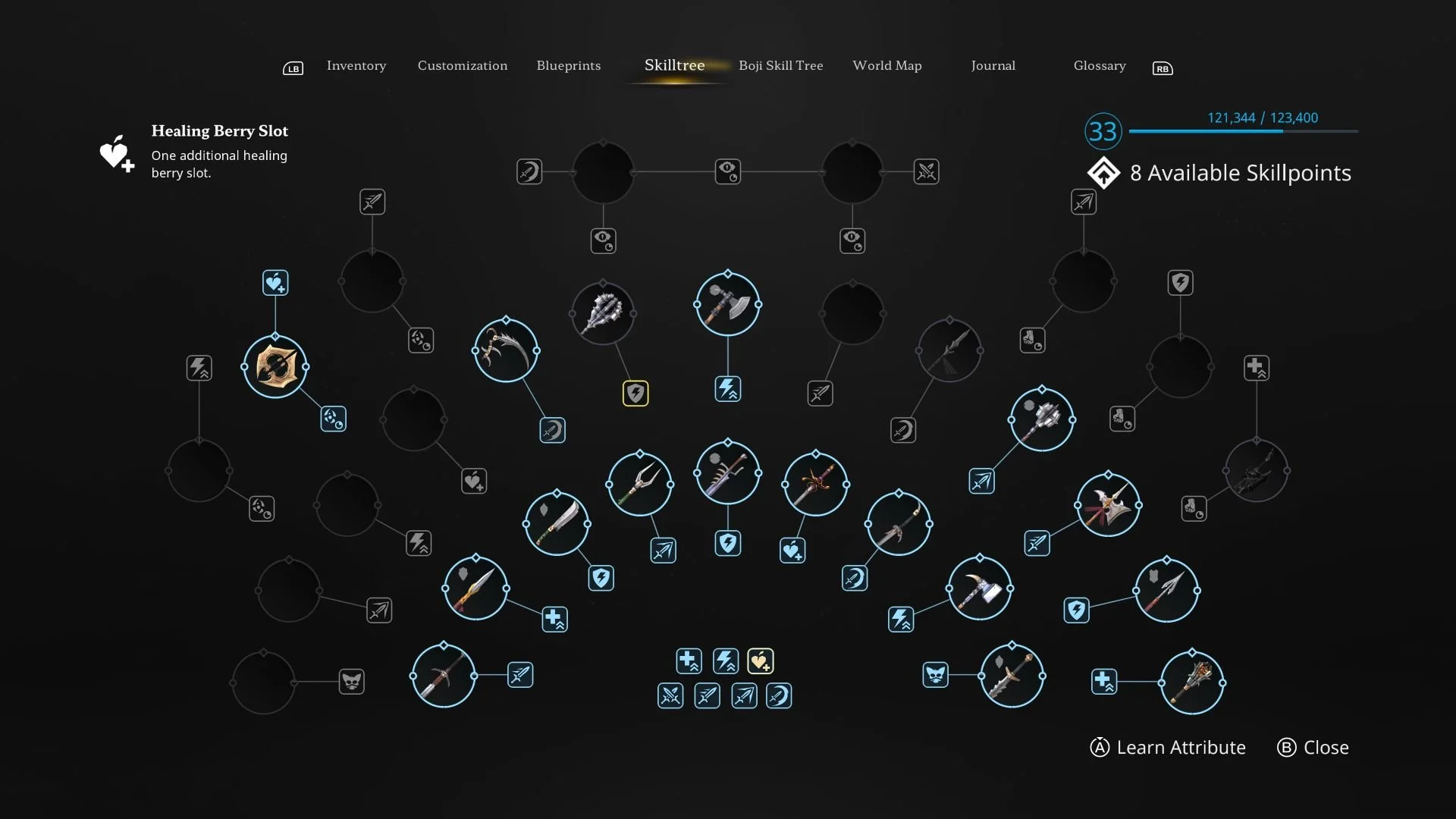A blade gone astray.
Stray Blade has an interesting premise. You play as an adventurer who enters the land of Acrea, a mysterious valley with just as many secrets as threats. And as soon as Farren arrives, they are killed and then resurrected, only to then discover they can never leave this valley. While its story and characters certainly bring some charm to this fairly by-the-numbers adventure, Stray Blade’s biggest problem is that it just isn’t that fun to play.
Stray Blade is, at its core, a Soulslike. While it bucks the trend and includes difficulty settings, the game itself still features many of the staples that define the genre. However, despite its allowance to cater the challenge to its player, its combat system swings the other way with its sluggish execution and failure to reliably convey its dodge or parry systems, often tripping over itself at nearly every encounter.
Upon your resurrection, you’ll eventually encounter Boji, a half-wolf half-Xhinnon being who knows the ins and outs of this land. He tells Farren that the only way they can leave this valley is by talking to his master, a man whom Boji himself is coincidentally on his own way to find. However, videogames being videogames, Boji tells Farren that the only way they can travel to him is to defeat three particular threats across this land first, each with their own general to take care of first.
Where Stray Blade differs from most Soulslikes is that Farren themselves is very clearly defined as a character. This is also something that Asterigos: Curse of the Stars shared as well, another cartoony Soulslike that I rather quite enjoyed, even if I didn’t have time to publish a review on. This allows Farren to have a voice here alongside the very talkative Boji, who will often spout endless details about the land and their current situation.
While I do adore this avenue of character interaction, Stray Blade sadly goes a bit too far here as Boji will constantly pop up to get your attention, sometimes multiple times in a span of five minutes. It’s a shame some of this dialogue couldn’t have been delivered on the go, removing the need to stop constantly to interact with him, and then hear out the often long-winded exposition. I do love the moments when they get to know each other more, It just becomes a bit too much sometimes.
Stray Blade’s valley of Acrea is comprised of separate zones that you’ll traverse, on the lookout for the entrance to the next zone, accompanied by a fairly short load time. Acrea may appear to be one massive environment on the map, but this is not an open world as gaming has often provided as of late. When you enter a new zone, it won’t appear on the map. You’ll need to find a sketch of that area before it will reveal itself on the map, showing you the paths and ways to navigate that area, even if there is no indication of altitude.
Each location is filled with chests and numerous secrets, largely consisting of crafting supplies that you’ll use to fashion new armor or weapons. Depending on your value for these things, exploration may or may not feel rewarding, but it certainly can be beneficial in the end. You’ll find shortcuts, elevators, and more, allowing for a faster way to return to previous areas, apart from the fast-travel mushrooms you’ll find occasionally. Given that most of these are on far sides of the map, they don’t quite reduce too much traversal if you are merely wanting to go to the next zone over.
While Stray Blade has a compass to aid in finding your way, it’s not really too effective as it fails to really aid you other than telling you where North is, for example. It illustrates that your target is in a particular direction, but fails to really give you any more detail than simply bringing up the map, which you’ll do pretty frequently, even if it can often add more to the confusion if you are taking the right path or not. Had the compass simply been a bread crumb trail ala Fable, then navigating this space would have been far slicker.
Replacing the bonfires here are the Acrean Life Shrines. While they don’t heal you, despite their name, they act as a checkpoint should you die. And, should you perish in battle, you’ll have to watch Boji bring you back to life in a lengthy unskippable cutscene each and every time. These shrines also never appeared to refresh enemies and instead, I found returning to these zones after I’d made a bit of progress to not only refill them with life again, but often seeing certain enemies move in, such as bandits and the like making camp in areas they weren’t found in before.
Stray Blade’s combat falls into two camps, how you take part in combat and what you take into combat via the fairly robust collection of weapons. The biggest fault lies with combat itself, so let’s dive into that first as it’s the game’s biggest problem. Much like other games in the genre, Stray Blade takes a few things to fill out core systems in its gameplay. We have a stamina system for a variety of attacks, parries, and dodges, to those very things themselves. Each foe you encounter will attack based on a color; red for dodges, and blue for parries. While dodging and parrying attacks should be straightforward, both systems’ timing is all over the place, simply due to each enemy often being misleading in when they flash blue or red and when they actually attack after those flashes.
If you manage to perfect parry the enemy will take massive poise damage, which is a similar system used in games such as Sekiro: Shadows Die Twice, Wo Long: Fallen Dynasty, and several more. This opens them up to pull off a variety of instant kill attacks, which despite the cartoony nature of the game, are rather brutal and bloody. If a perfect dodge is performed, the energy used to dodge is returned back to you. These systems sound great on paper and while they can work as intended, the inconsistency in knowing when to perform some of these options vary on each different enemy type, giving you a lot to remember and keep track of.
Most enemies will flash either red or blue depending on what they are planning to do; however, some enemies have a 4 to 5 second delay in performing their chosen attack after the flash. This means you have to pay attention to them both during the flash and after to gauge what exactly they are doing. If this game was entirely that of one on one encounters, this wouldn’t be much of an issue, but trying to manage three or four enemies at once while trying to keep track of each of their blue and red attacks can be utter nonsense at times. If the game simply had you parry attacks as they happened or dodge those same attacks to create a gap between the both of you, then we’d be having a very different discussion here. I applaud the game in trying to do something new, but its execution just doesn't deliver.
This system is further an issue due to enemies not being stunned or affected by many of your attacks, which to be honest are pretty slow-acting and sluggish, regardless of what weapon you are using. This isn’t a constant problem as some enemies do appear to be staggered by your attacks, but the large majority seemed to be unphased by any efforts you make towards them in combat and often attack through your strikes, making combat a mess at times.
Farren can strike with either a light attack, a heavy attack, or a special attack. These attacks all vary in their speed and damage, but when it comes to performing those attacks, Farren’s stamina consumption is incredibly harsh, often seeing you deplete your whole stock in a few swings and dodges, leaving you empty and unable to attack. While pulling off parries and dodges is a good way to get it back, having a whole game revolve around an inconsistent system is a bad choice and just doesn’t deliver here. In the end, it makes combat feel tiresome, boring, and simply not fun. And since enemies can often stun-lock you with their parry attacks, it’s possible to be bounced around by a group of enemies and never able to get back to your feet in time to do anything about it.
Adding to Farren’s repertoire of skills are a few special skills you’ll earn as you defeat the three central bosses. The Intium Flash allows you to teleport to key objects in the environment but also allows you to teleport towards an enemy, which is crucial during one boss encounter. While this used as a means to attack is fine, it can often leave you open to an attack when used. The Manninite Pound is used to slam rocks into position for some platforming but can also be used during combat as well, knocking back enemies to give you some space. Lastly, the Xhinnon Vision will make hidden paths tangible and can be used in combat to freeze enemies in place for a short time.
If combat was faster and less clunky in anything you were doing, then you could salvage some fun out of this adventure, especially if certain weapons balanced it out. And while that is sometimes the case, you’ll rarely find a weapon that has everything you want it to do. I ended up finding a few that provided some sense of speed but opted for damage output at the end of the day. Regardless of whatever I chose, nothing overcame the deeper problems I had with combat or the parry and dodge systems.
Wielding different weapons is the key to making Farren more powerful as while you’ll unlock skill points by leveling up, those points don’t go into core stats to improve Farren themselves, but their weapons instead. As you find or craft a weapon, you’ll need to use it until it has been mastered. There are runes you can equip to weapons to make them perform a variety of attacks and buffs, and one of them is increasing your mastery earns to level that weapon up faster. Once you achieve master rank, you can then use those skill points.
Now, depending on how many resources you’ve gathered, or how much you explore, your allotment of those resources and what blueprints you have will detail how much health Farren has, their stamina gains, and how powerful their attacks are. Each weapon has one trait to improve, with unique weapons that you’ll find in special areas having two, but these weapons must be crafted at a special place. Regular weapons need to be crafted at camps that have a blacksmith station, which, to be honest, are practically everywhere.
The biggest issue here with this system is being able to find those weapons, earning them, and then hoping you have the items needed to upgrade them as those resources are also used to craft your armor, which has various upgrades for health, stamina usage, and more. Balancing that out can be a bit tricky and requires a lot of grinding to really have everything you want. At most points in the game, I had a ton of skill points that I couldn’t use since I was using my resources to craft new armor, often since I found weapons that I enjoyed using and often stuck with them. Still, I would have to craft a weapon every now and then that I ended up not liking whatsoever so that I could add another health slot to Farren’s total. It’s not a bad system, but I feel something else would have been better suited here.
Boji himself has his own skill tree as well, upgraded as you encounter certain knowledge tomes. These, like the chests and other collectibles, are hidden everywhere, but certainly stand out from a distance. As you increase his capability, he can jump into combat with you to a certain extent, firing off a blast that can deplete enemy poise and more. I didn’t find him terribly useful all the time and often forgot about him entirely during most encounters. His best ability is being able to resurrect you in battle should you fall, but even then I found that to be wildly inconsistent.
When it comes to the game’s presentation, that is likely its best asset. Menus and UI function fine apart from attempting to navigate the very basic compass. Its visual style is almost something akin to if there was a Torchlight adventure game from a third-person perspective than that of its isometric roots. The worlds suffer from a few bad design choices but consistently pull off its decent visuals in a clean and colorful aesthetic.
Stray Blade is also massively unfinished when it comes to polish. I had several glitches and issues throughout my entire time with it, such as stat windows appearing whenever a cutscene or dialogue moment would end and remain on the screen until I was nowhere near combat to open a menu and refresh the screen. One example where this was a massive issue was a large stat window being present during the game’s second boss. It was such a large prompt window that I couldn’t even see what the boss looked like. And since I couldn't open the menu due to being in combat, I had to do the entire battle with this annoyance being front and center. The window, as shown below, also featured a certain F word just staring me in the face. This is one of several glitches that would constantly be present during my journey.
Stray Blade is a game I really wanted to enjoy, in fact, I can see a version of this game that is absolutely incredible. Its cartoony visuals and unique take on the Soulslike had promise, but ultimately ended up being a game that I just didn’t enjoy most of my time with. If you are looking for a similar take on the Souslike formula in this type of setting and aesthetic, then I strongly suggest TinyBuild’s Asterigos: Curse of the Stars instead as they pretty much execute on everything they were attempting to do there. Stray Blade could see a lot of its systems and mechanics fixed in updates, not to mention a few technical blemishes and glitched achievements, but as it stands, Stray Blade is another Soulslike that is destined to be forgotten.
Developer - Point Blank Games. Publisher - 505 Games. Released - April 20th, 2023. Available On - PlayStation 5, Xbox One, Xbox Series X/S, PC. Rated - (M) Blood, Violence. Platform Reviewed - Xbox Series X. Review Access - A review code was provided by the publisher for the purpose of this review.




















Jeff is the original founder of Analog Stick Gaming. His favorite games include The Witcher III, the Mass Effect Trilogy, Hi-Fi Rush, Stellar Blade, Hellbade: Senua’s Sacrifice, and the Legend of Heroes series, especially Trails of Cold Steel III & IV.